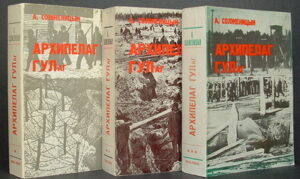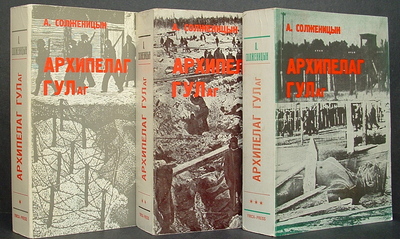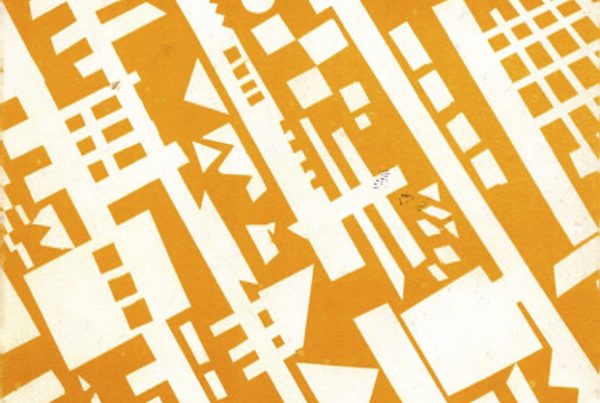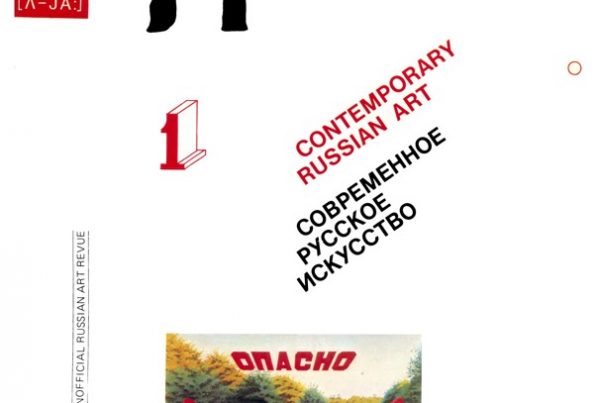
Source: picture submitted by the author.
Title:
Arkhipelag Gulag [The Gulag Archipelago]
Author: Aleksandr Isaevich Solzhenitsyn (1918-2008)
Publishing House: Mondadori
Place: Milano
Years: 1974-1978
Description:
The first volume of the Italian version of The Gulag Archipelago was published by Mondadori in May 1974, a few months after the YMCA Press edition in Paris. The second and third volumes were published by Mondadori in February 1975 and in May 1978. This article mostly takes into account the response connected to the first volume published in 1974.
The Gulag Archipelago is a precise and complex record of the Soviet concentration camp system presenting the testimonies of prisoners and outlining the history of Soviet repression, whose roots are identified in the October Revolution and, controversially, within the very theoretical premise of Marxism.
The work was published against the background of the Cold War, and generated fierce debate in Catholic and Marxist circles and was widely discussed in the press.
The political-ideological position of Solzhenitsyn and his interpretation of history which traced connections between Stalinism, the Revolution and Marxism was the main focus of the debate in Italy. The Italian Left criticized his analysis; the PCI (the Italian Communist Party) and left wing extra-parliamentary groups were mistrustful of the dissenting author and found Solzhenitsyn’s views embarrassing because they undermined fundamental pillars of their political beliefs.
The PCI, committed to projects that were not always appreciated by Moscow such as Eurocommunism and Historical comprise, refused to take a position on the book to avoid antagonising the Soviets. Moreover, Solzhenitsyn was criticized for his explicit mistrust of the Detentè process, which was considered by the institutional Left the only way for the USSR to move towards democracy (cf. Sensini 2007).
The extra-parliamentary left attributed to Solzhenitsyn a conservative and right wing vision of history, and even accused him, among other things, of favouring of the Pinochet regime, expressing distaste for the general political direction of his reasoning (cf. Lomellini 2010). The actual contents of Archipelago were pushed to the margins and ideologically motivated criticism, typical of the Cold War period, prevented a less polarised analysis of the work. Accusations of anti-communism prevailed and the work’s content was largely ignored.
This negative response, was not, however, universal and there was a positive reception in some left wing circles of the book’s ethical and political themes. The PSI (the Italian Socialist Party), for example, regarded Solzhenitsyn as an important part of the campaign of Dissent and used his work as proof of the unreliability and ambivalence of the PCI’s attitude towards the CPSU (cf. Sensini 2007).
The weekly magazine “L’Espresso” dedicated significant space to the “case” and led the campaign in favour of Solzhenitsyn by contextualising the criticism of his work and outlining the editorial events and differing intellectual positions that influenced the debates. The magazine opened a discussion on Soviet repression.
Some Marxist intellectuals, although dissociating themselves from Solzhenitsyn’s historical and political interpretations, saw the need to engage with the work and its author. Among these were F. Fortini, V. Strada, L. Foa, P. Sinatti and R. Rossanda, who denounced the mistrustful attitude of the Italian left towards Solzhenitsyn and Dissent in general (cf. Fortini 1971 e 1974, Strada 1976, Foa 1974, Sinatti 1974 and Rossanda 1977).
Reception of Solzhenitsyn’s work among Catholics and liberals, who on the whole saw Soviet repression as an inevitable consequence of Socialism, was more positive. Gustav Herling, among the first to review the work in Italy, defined Archipelago as “a colossal monograph of the legalisation of terror”, whose history did not start with Stalin, but with the Revolution (Herling 1974: 12).
For “La Fiera Letteraria”, evidence from the gulags represented a condemnation of communist ideology, as “the horrors of the Soviet concentration camp” were the only possible consequence of Marxist revolution.
The Vatican State magazine “Civiltà Cattolica” emphasized the spiritual message voiced by Solzhenitsyn, highlighting the impossibility of achieving Christian ideals within Soviet socio-economic structures. There was, nevertheless an attempt to separate Solzhenitsyn’s interpretation of history from the more reactionary aspects of his politics; the liberals rejected the nationalistic character of his arguments which had strong Slavophile and anti-western tones and which several Italian intellectuals considered similar to the tenets of Fascism (cf. Bo 1974 e Ronkey 1974).
The idea that Archipelago was practically ignored by the press and the Italian intelligentsia in the 1970s is not born out by the evidence. The book was widely discussed after its publication, although, perhaps, its true importance was not fully appreciated due to the tendency of those involved in the debate to regard it through superficial, ideologically tinged lenses (cf. Reccia 2019).
Alessandra Reccia
[30th June 2021]
Translation by Diletta Bacci
Bibliography
- Solzhenitsyn A., Lettera al IV Congresso dell’Unione degli Scrittori, 1967, Rome 1967.
- Solzhenitsyn A., Arcipelago Gulag, [1973], Milan 1974.
- Solzhenitsyn A., Vivere senza menzogna, [1973], Milan 1974.
Critical Papers
- Guagnelli S., Rane, elefanti e cavalli. Vittorio Strada alla Biennale del dissenso, “E-samizdat”, VIII (2010-2011): 317-329.
- Herling G., Dialogo su Solženicyn con Nicola Chiaromonte, id., Gli spettri della rivoluzione, Ponte alle Grazie, Firenze 1994: 150-159.
- Lomellini V., L’appuntamento mancato. La sinistra italiana e il Dissenso nei regimi comunisti (1968-1989), Le Monnier, Firenze 2010.
- Poggio P. (ed.), Il Dissenso: critica e fine del comunismo, Venezia 2009.
- Reccia A., Narrazione del silenzio e dibattito nella prima ricezione diArcipelago Gulag in Italia, in L. Jurgenson, C. Pieralli (eds.), Lo specchio del Gulag in Francia e in Italia. La ricezione delle repressioni politiche sovietiche tra testimonianze, narrazioni e rappresentazioni culturali (1917-1987), Pisa University Press, Pisa 2019: 323-342.
- Sabbatini M., Lagernaia proza Solzhenitsyna v zerkale ital’ianskoi kritiki 1960-ch nachala 1970-kh godov, in Tekst i traditsiia. Al’manakh, 6 (2018): 51-62.
- Sensini P., Il Dissenso nel movimento della contestazione italiana dal 1968 al 1977, inIl Dissenso: critica e fine del comunismo, ed. by P. Poggio, Marsilio, Venezia 2009: 169-187.
- Sinatti P. (ed.), Il dissenso in Urss. Le ragioni politiche e culturali dello schieramento antistalinista in Unione Sovietica, Savelli, Roma 1974.
- Strada V., Dissenso e socialismo, in AAVV, Dissenso e socialismo. Una voce marxista del Samizdat sovietico, Einaudi, Torino, 1976: VII-XXIX.
Magazines and daily newspapers
- Bettiza E., Solzhenytsin il profeta rifiutato, “La Stampa” (Cultura e società), September 26th (1990): 15.
- Bo C., Il testimone che parlava, “Corriere della Sera”, February 14th (1974).
- Citati P., Memorie del terrore, “Corriere della Sera”, June 16th (1974): 12.
- Foa L., Il dissenso in Urss, “Quaderni piacentini”, 51 (1974): 93-95.
- Fortini F., Più velenoso di quanto pensiate, “Quaderni piacentini”, 44-45 (1971): 221-227.
- Fortini F., Del disprezzo per Solženicyn,“Il Manifesto”, March 21st (1974): 3-4.
- Glucksmann A., Ma quel Gulag turbò anche la destra, “Corriere della Sera, August 2nd (1994): 19.
- Herling G., Arcipelago: la recensione, “Corriere della Sera”, February 24th (1974): 12.
- Moravia A., La paura della verità, “Corriere della Sera”, February 13th (1974): 1.
- Ostellino P., Meno martiri e più politica nel dissenso dopo Solgenitsin, “Corriere della Sera”, February 16th (1974): 18.
- Ronchey A., L’antipatico Solženicyn, “La Stampa”, April 17th (1974): 3.
- Rossanda R., Intervista a Leonid Pljušč, “Il Manifesto”, May 31st (1977): 5.
- Sinatti P., La rottura del silenzio all’inizio degli anni Sessanta, “Il Manifesto”, January 23rd and 25th (1974): 3-4.
To cite this article:
Alessandra Reccia, The Italian reception of “The Gulag Archipelago”, in Voci libere in URSS. Letteratura, pensiero, arti indipendenti in Unione Sovietica e gli echi in Occidente (1953-1991), a cura di C. Pieralli, M. Sabbatini, Firenze University Press, Firenze 2021-, <vocilibereurss.fupress.net>.
eISBN 978-88-5518-463-2
© 2021 Author(s)
Content license: CC BY 4.0





